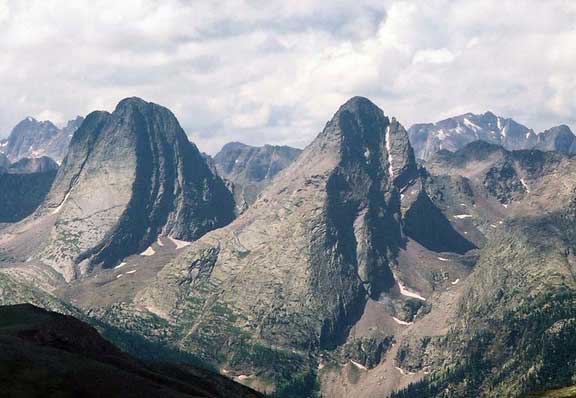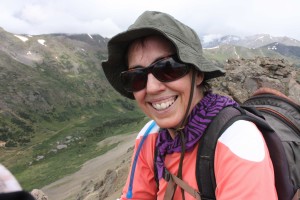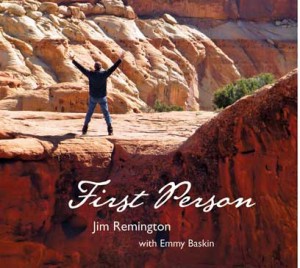by Jane Koerner
 My turn to tie into the umbilical cord, the dangling rope. I start around the corner, and the route to the top of Dallas Peak disappears into thin air, like Will did 45 minutes ago when he took the lead. Once my eyes adjust to the glare, I realize I am standing on a snowed-in ledge that leans away from the mountain, toward Blue Lake 2,000 feet below. My postholes in the snow cannot take the heat at this altitude, and the only secure route back to terra firma, and to John, who is awaiting his turn, collapses.
My turn to tie into the umbilical cord, the dangling rope. I start around the corner, and the route to the top of Dallas Peak disappears into thin air, like Will did 45 minutes ago when he took the lead. Once my eyes adjust to the glare, I realize I am standing on a snowed-in ledge that leans away from the mountain, toward Blue Lake 2,000 feet below. My postholes in the snow cannot take the heat at this altitude, and the only secure route back to terra firma, and to John, who is awaiting his turn, collapses.
The ledge looks like it will run out soon and then what? Dump me? I break the golden rule of mountaineering and look into the bottomless void and pray for a search and rescue chopper. Maybe I can fake a sprained ankle. Except for an occasional tug on the rope and his disembodied “Off rope!” Will hasn’t kept in touch. I shout at him to tighten the rope. The wind thunders. He can’t possibly hear me. The rope jerks to maximum tension. He must be up there somewhere, guiding the rope, protecting us both with properly positioned chocks and slings. If I slip and his anchor fails, the rope in his lap might unwind in a heartbeat, grabbing him by the ankles, and we’ll both fall off.
A bonk rattles my helmet, then another. Bullseye. Rocks have landed on the black X I taped to the top of my helmet for good luck. I shake them off. Three chocks nest on the buckle to my climbing harness. The protection Will placed on the traverse must have popped loose and slid down the rope. “Tighten!” I yell. The wind howls back. The rope doesn’t move. My cries will never reach him.

At the end of the ledge looms a thank-God-there-is-a-chimney of consolation to mountaineers like me with vertigo. The chimney is filled with rotten snow and loose rock. Either I commit to the climb or I shriek at Will to feed me more rope for the retreat.
I flail at the first lift up until the frontpoints of my crampons catch. Left point, right point, ice axe swinging at any mark in the rock that resembles a crack. An unorthodox technique, to be sure, but I don’t give a damn because there is my reflection in the eye of Will’s 55-millimeter lens. I crawl past and sit as far from the edge as possible. John soon joins us, standing upright every step.
I manage a victory smile as Will wraps his arm around my shoulders for the summit portrait. Of the 100 highest peaks in Colorado, we have just climbed the toughest one. Eighty-one down. Nineteen to go. Will researches the access and the routes; I keep score with dates in the margins of our list.
We climb from Memorial Day weekend until the snow sticks, our topo maps guiding us through cliffs without mishap. By our third summer of mountaineering they fill an entire drawer in our file cabinet.
The summits are scattered across seven mountain ranges. Their names conjure a history of Ute nomadism and Spanish exploration and American conquest. (Chief) Ouray, with a view of the mountain range and valley that fed his people with its abundant wildlife. Culebra and Crestone, whose steep descent earned our undying respect. Rio Grande, where the coyotes kept us up half the night as we shielded the dog in our tent. (Zebulon) Pike, (Ulysses B.) Grant and Kit Carson. Pigeon and Turret, the backpack from hell. (Father) Dyer, Holy Cross and Cathedral, which lived up to its reputation for hair-raising lightning storms. Silverheels, the anonymous prostitute who nursed the miners of Fairplay through a smallpox epidemic only to catch the disease herself. She covered her ruined face with a veil and vanished. In her memory, I strip off my jacket on the way down, wrap it around my hips and roll down the mountainside, tumbling to a stop in a bed of alpine forget-me-nots and moss campion cushions, unharmed.
Ten or more summits a season, and we lose our way only a few times, arriving on top after a lengthy, scenic detour. Weekdays we work to pay the bills, recovering as best we can from wind-burnt lips, sore knees and bruised toenails. During back-to-back integrated marketing meetings, while team leader Ted assigns the same messages my employer has been trumpeting from sea to shining sea for the past three years, I slip off my shoes and plot our next adventure in my notebook.
[InContentAdTwo]
On weekend forays into the mountains, Will’s Bronco consumes two sets of tires, not counting blown and shredded ones, and the steering wheel locks up on a treacherous four-wheel-drive road. My resoled boots finally give up the ghost when the right heel disappears in a boulder field.
Sometimes I climb alone. I learn to recognize the tingle of electricity on my scalp in time to dodge an incoming lightning bolt, identify a peace-loving skunk in the dark, locate a summit in the fog. The coyotes, too wary of humans to reveal themselves, keep me company with their ventriloquists howling; the elk lead me safely through the cliff bands, the tracks from their seasonal migrations providing stirrups for the scramble up.
Elk Range, late fall: The tourists have gone home, defeated by the cold, resigned to the resumption of habitual routine. We are the only party on the mountain. Somewhere above us, lost in mist, the last mountain on our centennial peaks list awaits us. It has no name.
We leave behind the stand of Engelmann and blue spruce where we pitched our tent, and pass Conundrum Hot Springs, moisturizing ourselves in the drifting steam. Braced for the ascent, we advance on the tipping saucer of the rock-strewn tundra. Patches of skunk cabbage sag in rusted heaps smelling of old library books. The higher we hike, the dicier the weather. Clouds swirl around us like smoke from a rampaging wildfire. Graupel bears down on us sideways, stinging our cheeks with first-degree burns. Will and John consult the compass so we can navigate in the fog. They shout their directions so they can be heard above the cacophony of the wind. The wind pastes icicles onto Will’s beard, sucks us dry and bends us into old women with arthritic spines.
We totter on, our determination to complete a nearly decade-long project propelling us upward. The celebration on the summit is brief. Will wears the top hat he purchased at Salvation Army and the tuxedo he wore to our wedding. John’s down tie flaps in the breeze, as blue as his eyes, as a Rocky Mountain sky in autumn. We name our nameless peak Mt. Gray because of the similarity between the rock and the weather, and the contrast with our mood. Oct. 11, 1981: Mission accomplished. I am the first woman to climb the Centennial Peaks.
Our celebration resumes in the hot springs among friends who have backpacked in a bottle of champagne and a floating tray of gourmet delicacies for the occasion. Deviled curried eggs, cranberry goat cheese, homemade angel food cake dipped in melted Ghirardelli chocolate. Having skipped the summit bid in favor of a prolonged soak, they withhold their congratulatory greetings until we strip and plunge in. Then the cork pops and the foam spurts. We lift our champagne glasses for the toast.
After our divorce, Will and I split the topo maps 50-50. Stained and torn now after 35 years of service, my share must be patched together with Scotch tape. Our dog’s hips wore out long before ours did. He is buried beneath a big spruce in Will’s backyard, his gravesite marked with a piece of rose-colored quartzite from one of many ascents of Pikes Peak. Will’s boxes of slides are gathering dust on a closet shelf. He promises to bequeath them to me before either one of us ends up in a nursing home. When my joints can no longer tolerate the punishment of a climb, I will relive my carefree youth with pictures of us on top, the string of mountains in the background lit up like stained glass in a cathedral.


